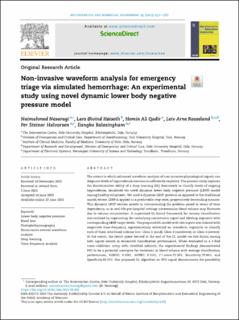| dc.contributor.author | Nesaragi, Naimahmed | |
| dc.contributor.author | Høiseth, Lars Øivind | |
| dc.contributor.author | Qadir, Hemin Ali | |
| dc.contributor.author | Rosseland, Leiv Arne | |
| dc.contributor.author | Halvorsen, Per Steinar | |
| dc.contributor.author | Balasingham, Ilangko | |
| dc.date.accessioned | 2024-02-05T08:33:25Z | |
| dc.date.available | 2024-02-05T08:33:25Z | |
| dc.date.created | 2023-08-28T14:53:36Z | |
| dc.date.issued | 2023 | |
| dc.identifier.citation | Biocybernetics and Biomedical Engineering (BBE). 2023, 43 (3), 551-567. | en_US |
| dc.identifier.issn | 0208-5216 | |
| dc.identifier.uri | https://hdl.handle.net/11250/3115438 | |
| dc.description.abstract | The extent to which advanced waveform analysis of non-invasive physiological signals can diagnose levels of hypovolemia remains insufficiently explored. The present study explores the discriminative ability of a deep learning (DL) framework to classify levels of ongoing hypovolemia, simulated via novel dynamic lower body negative pressure (LBNP) model among healthy volunteers. We used a dynamic LBNP protocol as opposed to the traditional model, where LBNP is applied in a predictable step-wise, progressively descending manner. This dynamic LBNP version assists in circumventing the problem posed in terms of time dependency, as in real-life pre-hospital settings intravascular blood volume may fluctuate due to volume resuscitation. A supervised DL-based framework for ternary classification was realized by segmenting the underlying noninvasive signal and labeling segments with corresponding LBNP target levels. The proposed DL model with two inputs was trained with respective time–frequency representations extracted on waveform segments to classify each of them into blood volume loss: Class 1 (mild); Class 2 (moderate); or Class 3 (severe). At the outset, the latent space derived at the end of the DL model via late fusion among both inputs assists in enhanced classification performance. When evaluated in a 3-fold cross-validation setup with stratified subjects, the experimental findings demonstrated PPG to be a potential surrogate for variations in blood volume with average classification performance, AUROC: 0.8861, AUPRC: 0.8141, | en_US |
| dc.language.iso | eng | en_US |
| dc.publisher | Elsevier | en_US |
| dc.rights | Navngivelse 4.0 Internasjonal | * |
| dc.rights.uri | http://creativecommons.org/licenses/by/4.0/deed.no | * |
| dc.title | Non-invasive waveform analysis for emergency triage via simulated hemorrhage: An experimental study using novel dynamic lower body negative pressure model | en_US |
| dc.title.alternative | Non-invasive waveform analysis for emergency triage via simulated hemorrhage: An experimental study using novel dynamic lower body negative pressure model | en_US |
| dc.type | Peer reviewed | en_US |
| dc.type | Journal article | en_US |
| dc.description.version | publishedVersion | en_US |
| dc.source.pagenumber | 551-567 | en_US |
| dc.source.volume | 43 | en_US |
| dc.source.journal | Biocybernetics and Biomedical Engineering (BBE) | en_US |
| dc.source.issue | 3 | en_US |
| dc.identifier.doi | 10.1016/j.bbe.2023.06.002 | |
| dc.identifier.cristin | 2170295 | |
| cristin.ispublished | true | |
| cristin.fulltext | postprint | |
| cristin.fulltext | original | |
| cristin.qualitycode | 1 | |

